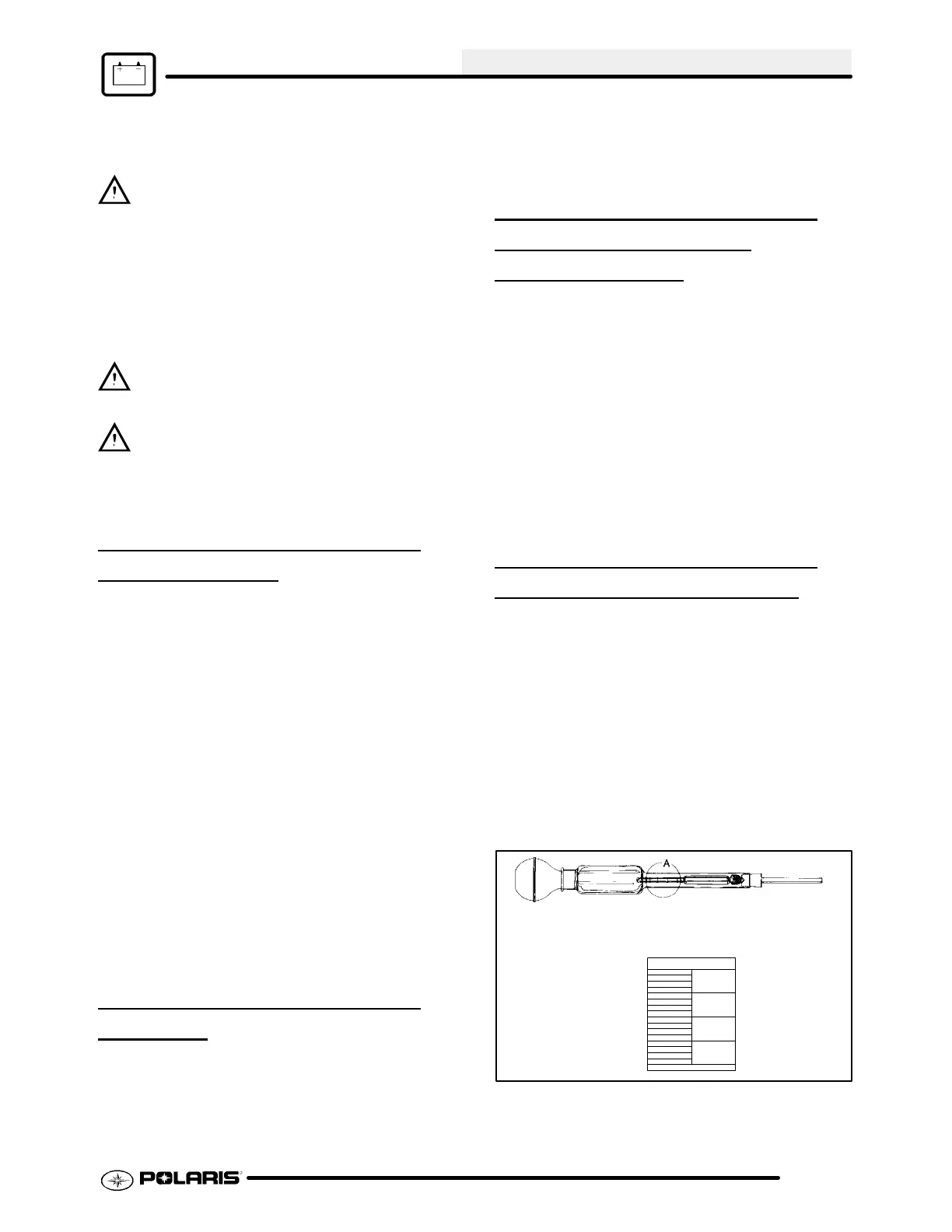ELECTRICAL
10.37
1. Disconnect holder strap and remove covers.
2. Disconnect battery negative (-) (black) cable first,
followed by the positive (+) (red) cable.
CAUTION
Whenever removing or reinstalling the battery,
disconnect the negative (black) cable first and
reinstall the negative cable last!
3. Remove the battery.
4. Remove the filler caps and add distilled water
only as needed to bring each cell to the proper
level. Do not overfill the battery.
Refill using only distilled water. Tap water
contains minerals which are harmful to a battery.
Do not allow cleaning solution or tap water inside
the battery. Battery life may be reduced.
5. Reinstall the battery caps.
CONVENTIONAL BATTERY
INSTALLA
TION
1. Clean battery cables and terminals with a stiff wire
brush. Corrosion can be removed using a solution
of one cup water and one tablespoon baking soda.
Rinse well with clean water and dry thoroughly.
2. Route the cables correctly.
3. Reinstall battery, attaching positive (+) (red) cable
first and then the negative (-) (black) cable. Coat
terminals and bolt threads with Nyogelt Grease
(PN 2871329).
4. Install clear battery vent tube from vehicle to battery
vent. WARNING: Vent tube must be free from
obstructions and kinks and securely installed. If not,
battery gases could accumulate and cause an
explosion. The vent tube should be routed away
from frame and body to prevent contact with
electrolyte. Avoid skin contact with electrolyte, as
severe burns could result. If electrolyte contacts the
vehicle frame, corrosion will occur.
5. Reinstall the holder strap.
CONVENTIONAL BATTERY
TESTING
Whenever a service complaint is related to either the
starting or charging systems, the battery should be
checked first.
Following are three tests which can easily be made on
a battery to determine its condition: OCV Test,
Specific Gravity Test and Load Test.
CONVENTIONAL BATTERY
OCV - OPEN
CIRCUIT
VOLTAGE
TEST
Battery voltage should be checked with a digital
multitester. Readings of 12.6 volts or less require
further battery testing and charging. See charts and
Load Test on below.
NOTE: Lead-acid batteries should be kept at or near
a full charge as possible. Electrolyte level should be
kept between the low and full marks. If the battery is
stored or used in a partially charged condition, or with
low electrolyte levels, hard crystal sulfation will form
on the plates, reducing the efficiency and service life
of the battery.
CONVENTIONAL BATTERY
SPECIFIC GRAVITY
TEST
A tool such as a Battery Hydrometer (PN 2870836)
can be used to measure electrolyte strength or
specific gravity. As the battery goes through the
charge/discharge cycle, the electrolyte goes from a
heavy (more acidic) state at full charge to a light (more
water) state when discharged. The hydrometer can
measure state of charge and differences between
cells in a multi-cell battery. Readings of 1.270 or
greater should be observed in a fully charged battery.
Differences of more than .025 between the lowest and
highest cell readings indicate a need to replace the
battery.
Detail A
1.10
1.15
1.20
1.25
1.30
Battery Hydrometer (PN 2870836)

